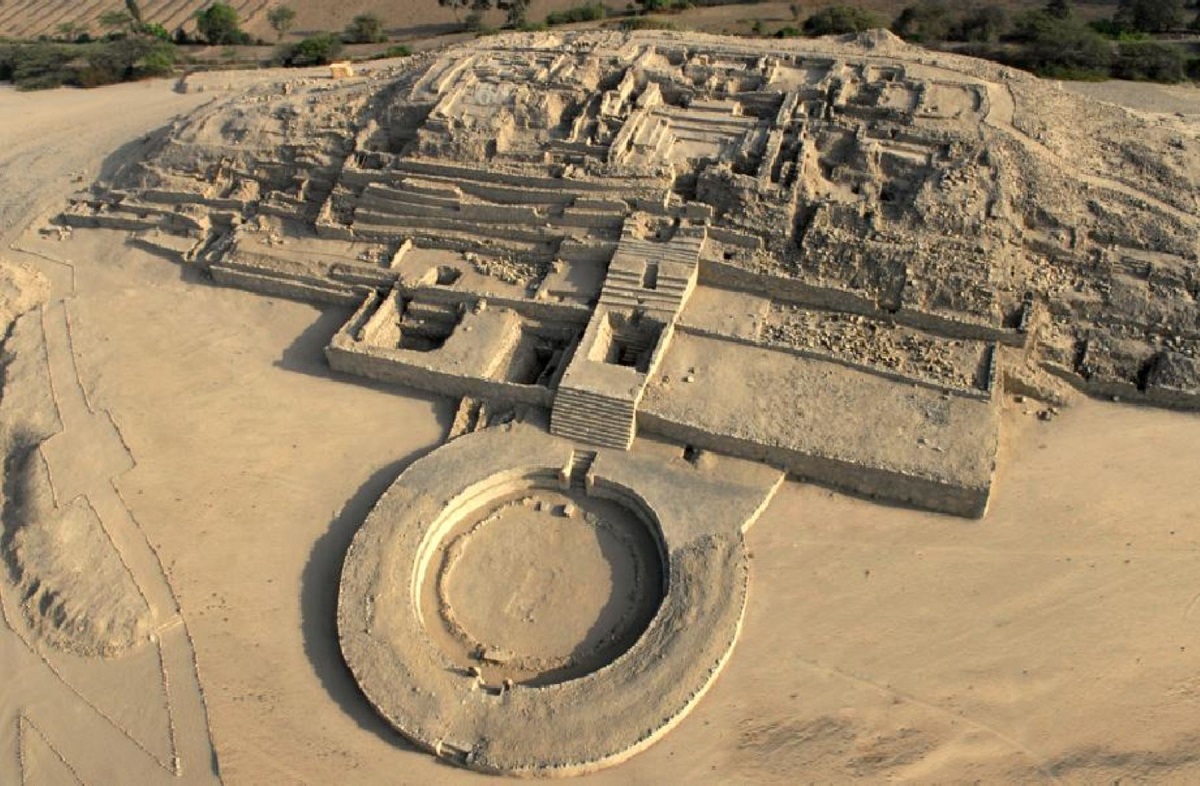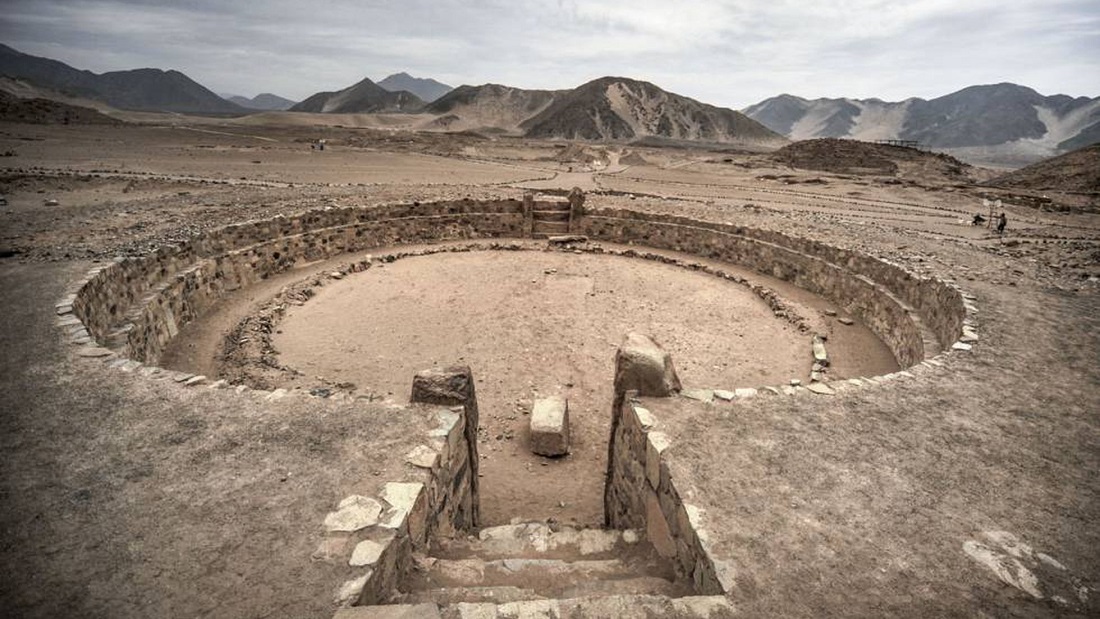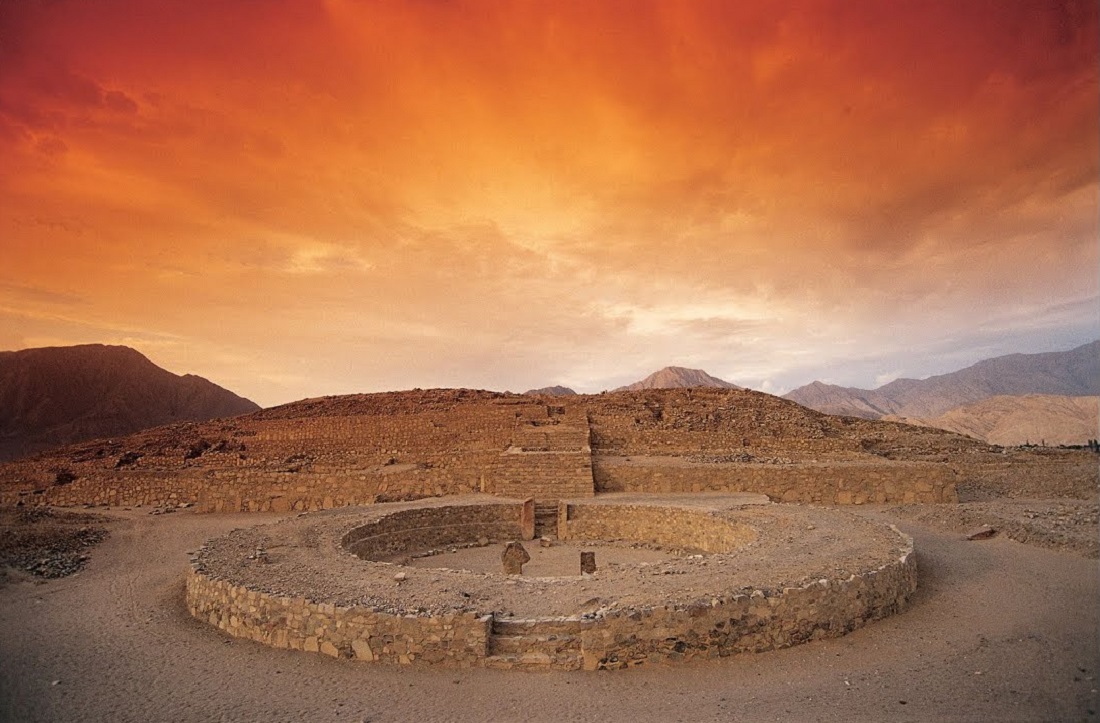
A few hours from the Peruvian capital, are the remains of an ancient city recognized in the world. The Sacred City of Caral represents the perfect place for travelers more interested in archeology and the mysteries of our past. The Sacred City of Caral is one of the destinations that must be visited at least once in a lifetime. Its proximity to Lima, just 184 kilometers to the north, allows access to this archaeological jewel declared a World Heritage Site and one of the main attractions of Barranca, a province that is home to a varied and captivating tourist offer. This 5,000-year-old archaeological site and the seat of the oldest civilization in America is located exactly in the district of Supe, located on a desert terrace in the middle of a rich valley that was the source of food for its inhabitants. Its appearance dates back to the Late Archaic period of the Central Andes.
The Sacred City of Caral, is located on a desert plateau and arid territory, in the district of Supe, on the left bank of the river of the same name, on a terrace in the province of Barranca, within the department and region of Lima; about 350 meters from sea level.
Caral Peru is one of the oldest cities in the world and the oldest known civilization in the Americas. It was built during the Andean pre-ceramic period and stands out for its advanced urban, social, and cultural development, despite not yet having pottery or weapons of war. Its social organization, monumental architecture, and complex cultural expressions make it a unique example of an early civilization.
The archaeological site was recognized as Cultural Heritage of the Nation in 2002 and later declared a World Heritage Site by UNESCO in 2009, which solidified its importance worldwide. Today it is considered an invaluable testament to the origins of civilization on the American continent.
The Sacred City of Caral is about 5000 years old, contemporary with other great civilizations like Egypt, Mesopotamia, India, and China. The archaeological complex extends over about 65 hectares and features stepped pyramids, sunken circular plazas, altars, and residential spaces, which shows a hierarchical and organized society with a high degree of urban planning.
The scientific discovery of Caral was made in 1994 by the Peruvian archaeologist Ruth Shady Solís, who still leads the research at the site today. Her studies revealed that Caral was not just an isolated city, but part of a network of interconnected settlements in the Supe valley. This finding revolutionized Andean history by showing that the Peruvian coast was one of the main centers for the development of the world's civilizations.

The Caral Culture is the oldest civilization in the Americas, and it is estimated that it was formed more than 5,000 years ago in Peru. No other older site and with the same level of complexity has been found in the entire continent. In Caral several monumental buildings stand out, and each one fulfills markedly different functions, whether administrative, religious or ceremonial.
Unlike other ancient civilizations such as those of Egypt or China, which came to interact with each other and shared their culture, research to date suggests that Caral developed completely in isolation, and that the city was an important religious and commercial point.
The ruins of the Sacred City of Caral extend over more than 60 hectares, and are made up of 32 remains of public structures, residential complexes, houses, and other peculiar buildings. Below is a list of the most important.
In Caral you can see at least seven pyramidal structures of considerable size, accompanied by plazas, amphitheaters and residential areas, as well as irrigation systems that reveal the advanced technology. Caral is usually divided into two areas that are simply called Caral Alto and Caral Bajo, to differentiate the areas destined for the State and the purely religious ones.
 Temple of the Amphitheater
Temple of the Amphitheater
These are some of the places that you will visit during the Caral tour. You will also enjoy the history of other smaller enclosures, such as the Atrium, the Main Enclosure or the Altar of the Sacred Fire.
Likewise, you will visit the Circular Plazas, which are large walled and circular spaces. Two can be seen, one in front of the Greater Pyramid (in the upper sector of Caral) and another in the Temple of the Amphitheater (in the lower sector of Caral).
There is still much to discover regarding the history of this city, since official archaeological excavations began in 1996 under the supervision of Dr. Ruth Shady. Do you know what is the most curious? No remains of weapons were found, nor was there any evidence of armies or organization of wars in the city.
Due to the finding of musical instruments, which have decorations with motifs of birds, snakes, human figures, etc., experts conclude that a refined culture lived here, dedicated to commerce, religion, and entertainment.
The entrance costs to the city of Caral are 11 soles for adults, 1 sol for children, seniors and schoolchildren, and 4 soles for university students. The guide service in the same city has a cost of 20 soles for a group of 20 people maximum. There is also a special circuit for people with motor disabilities.

To reach Caral from Lima, you have several options depending on your budget and travel preferences. The most convenient way is by booking a guided tour, as many agencies offer full-day trips that include transportation, a guided visit to the archaeological site, and sometimes a stop for lunch in a nearby town. This option allows you to explore Caral without worrying about logistics.
If you prefer to drive yourself, you can take the Panamericana Norte highway from Lima and head north for approximately 180 kilometers until you reach the town of Supe, near Barranca. From there, you must take a dirt road for about 23 kilometers to reach the archaeological site. The total drive takes around four hours, and while a 4x4 vehicle is not necessary, the road conditions can be rough.
For budget travelers, public transportation is also an option. You can take a bus from Lima to Supe or Barranca with companies such as Z Bus, Turismo Paramonga, or Movil Tours, which depart from Plaza Norte. The journey takes about three to four hours and costs between 20 and 40 soles (approximately 5 to 10 USD). Once in Supe or Barranca, you will need to hire a colectivo or private taxi to take you to Caral, which can cost between 30 and 50 soles (around 8 to 14 USD) and takes about an hour.
Upon arrival at Caral, visitors must pay an entrance fee of 11 soles (around 3 USD). The site is open from 9:00 AM to 4:00 PM, Tuesday to Sunday. A guided tour is mandatory for all visitors, and local guides are available on-site for a small additional fee.
Next to Huaura and Huaral is Barranca, one of the three provinces of the "Norte Chico". Once your visit to Caral is over, you can tour this province and enjoy its festivities, depending on the date you travel.
The province of Barranca offers a series of tourist attractions that have the Safe Travels seal that accredits them as bioinsurance for tourism.
The beauty of the Barranca coastline is expressed in beaches such as Atarraya, Carabela, Caleta Vidal, Chorrillos, El Amor, El Colorado, Lampay, La Viuda, Miraflores, Punta del Áspero, Punta Supe, Puerto Chico, among others located between kilometers 182 and 204 of the Panamericana Norte highway.
These beaches are lapped by generally calm waves for relaxation, although it is also possible to go into the sea to successfully practice sports such as surfing and other nautical sports. In fact, Barranca has been the scene of several championships in these sports disciplines.
One of the emblematic attractions in Barranca is the viewpoint of Cerro Colorado, located south of the Chorrillos spa. There stands out the sculpture of Christ the Redeemer, 20 meters high. Also noteworthy is Caleta Vidal, a small fishing community surrounded by farms and desert hills that give it a unique panorama of tranquility.
In addition to Caral, the Paramonga fortress, a ceremonial construction built by the Chimú civilization (1100-1400 AD) and later occupied by the Incas (1440-1532 AD) is another must-see site. Upon entering the central pyramid, you can appreciate the Inca architectural design, with several passageways and entrances that lead to the highest area of the complex.
Bolivarian Museum
Located at kilometer 204 of the Panamericana Norte, in the Pativilca district, this facility welcomed the liberator Simón Bolívar during the summer of 1824 and the existing atmosphere of tranquility helped him recover his good health.
During his stay in this building, which became his headquarters, the liberator organized his army to support the decisive battles of Junín and Ayacucho that sealed the independence of Peru and South America. Currently, this property functions as a museum and exhibits furniture and documents from that time.
The culinary offer of Barranca has among its ambassadors dishes like the famous Tacu Tacu, prepared with beans and cooked rice that are accompanied with fish, shellfish, beef, chicken, pork, among others.
The wide range of fish and hydrobiological species that are extracted from the vast sea allow the preparation of various varieties of cebiche, ambassador of Peruvian cuisine in the world. Other emblematic delicacies are the “Meneao de pavo”, the Supe tamales, the crab stretcher, the supana sausage, the chicharrón, as well as unforgettable desserts such as the alfajor called “Tieso de miel”.
The regional and local authorities, with the support of the central government, are articulating efforts in terms of security, decoration and cleanliness, as well as an intense tourist promotion to consolidate Barranca as an ideal destination to visit not only in the summer season, but throughout year.
Peru offers unique experiences that show impressive landscapes, archaeological sites, and living traditions, attracting travelers who seek adventure and discovery in each region of the country. Get to know some of the most recommended trips to explore its diversity.
Inca Trail, Machu Picchu and more